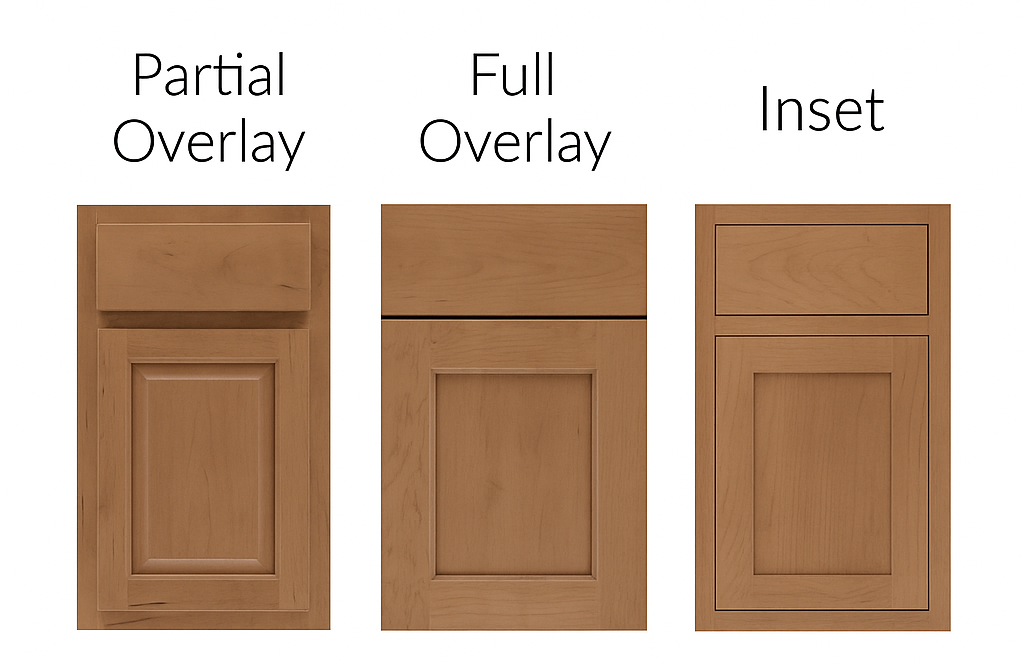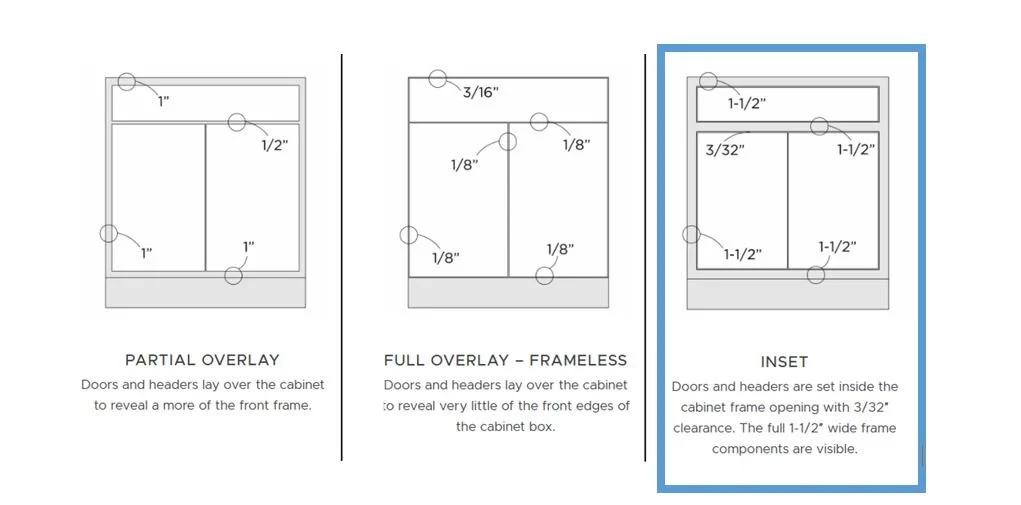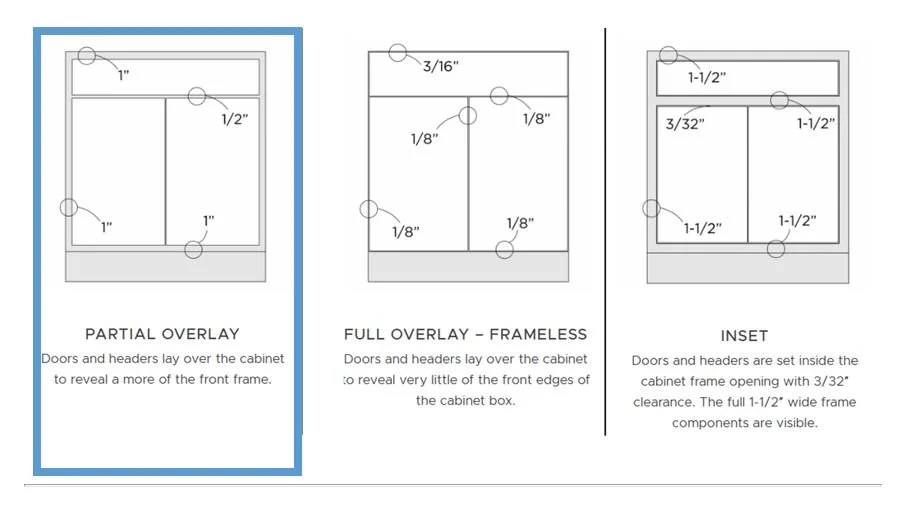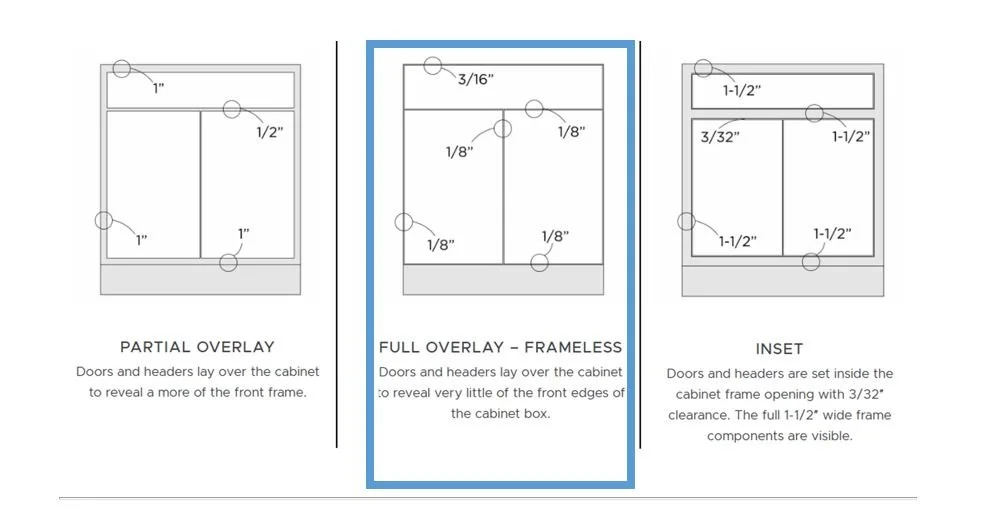
Cabinet Design 101
Inset vs. Partial Overlay vs. Full Overlay Cabinetry: What’s the Difference?
When planning a kitchen, bathroom, or built-in project, one of the most important design decisions is the cabinet door style. While color, wood species, and hardware often get the spotlight, the construction style of the doors and drawers has an even greater impact on the overall look, cost, and craftsmanship of your cabinetry. The three most common styles—Inset, Partial Overlay, and Full Overlay—each offer their own design personality and functional advantages. Here’s what clients should know before choosing.
Inset Cabinetry: Classic Craftsmanship & Precision Fit
Inset cabinetry is the most traditional and highest-craft construction method. In this style, the doors sit perfectly inside the cabinet’s face frame, flush with the front surface—much like a fine piece of furniture. Achieving this clean, tailored appearance requires extremely tight tolerances, careful joinery, and detailed installation.
Why clients love inset:
The refined, furniture-quality look
Crisp shadow lines and perfect alignment
Works beautifully with shaker, slab, and beaded-frame designs
What to consider:
Because inset doors sit inside the frame, they require precise construction and ongoing fine-tuning. They are also more sensitive to seasonal wood movement. This level of craftsmanship places inset cabinetry at the highest price point.
Partial Overlay Cabinetry: Traditional With a Classic Reveal
Partial overlay (sometimes called “standard overlay”) is what many people associate with classic American cabinetry. Here, the doors cover only part of the face frame, leaving a visible gap around and between doors. This results in a warm, traditional, and slightly more detailed appearance where parts of the frame intentionally show through.
Benefits of partial overlay:
A timeless, familiar look
Works well in traditional, craftsman, or cottage-inspired spaces
More budget-friendly than inset construction
Visual characteristics:
You’ll notice a consistent reveal around the doors—often about ½ inch. The exposed frame becomes part of the design, adding dimension and shadow lines that contribute to a welcoming, classic aesthetic.
Full Overlay Cabinetry: Modern, Clean, and Seamless
Full overlay cabinetry is the modern standard for custom and frameless cabinet systems. With this style, doors and drawers cover nearly the entire face frame, leaving only minimal gaps between units. This creates a smooth, continuous façade ideal for both contemporary and transitional designs.
Why homeowners choose full overlay:
Sleek, streamlined appearance
Maximizes interior storage space
Offers a high-end look without the cost of inset craftsmanship
Design impact:
Because the doors visually touch, the cabinetry feels unified and clean. This style is versatile and works well with minimalist slab doors as much as modern shaker profiles.
Which Style Is Right for Your Project?
Inset is perfect for clients who want the highest craftsmanship and a classic, furniture-grade look.
Partial overlay offers a traditional, budget-friendly option with charming exposed frame detail.
Full overlay delivers a modern, seamless aesthetic with excellent storage efficiency.
Cabinet Door Styles: Slab, Shaker, and Cope-and-Stick
When designing a kitchen, bathroom, or custom built-in, the cabinet door style is one of the most defining visual elements. While clients often focus on colors and hardware, the construction style of the cabinet door is what truly shapes the character of the space. Three of the most common and timeless styles we build—Slab, Shaker, and Cope-and-Stick—each bring a different design personality, level of detail, and architectural impact. Here’s what homeowners should know.
Slab Doors: Clean, Modern, and Minimalist
Slab doors (sometimes called flat-panel doors) are the most streamlined and modern cabinet door style. They are made from a single, smooth panel with no frame, no rails, and no recessed or raised sections. This simplicity creates a ultra-clean, contemporary look that works well in both modern and Scandinavian-inspired spaces.
Why clients love slab doors:
Sleek, minimalist design
Easy to clean with no grooves for dust or grease
Perfect for modern, transitional, or European-style kitchens
Design impact:
With uninterrupted surfaces, slab doors create strong visual lines and emphasize material choice—whether that’s painted MDF or a beautiful wood veneer. They pair well with integrated pulls, edge pulls, or minimalist hardware for a seamless appearance.
Shaker Doors: Versatile, Classic, and Universally Loved
Shaker doors are the most popular cabinet style in America today. Characterized by their five-piece construction—a flat center panel framed by four rails—they strike the perfect balance between clean design and subtle detail. Shaker cabinets work in almost any design style: farmhouse, coastal, modern, transitional, or traditional.
Why clients choose shaker:
Simple but refined
Works with almost any interior style
Offers a timeless look that doesn’t date quickly
Design flexibility:
Shaker doors can look modern in a crisp white finish with simple hardware, or more traditional in a stained wood with decorative pulls. Their recessed panel adds architectural interest without feeling busy.
Cope-and-Stick Doors: Detailed Craftsmanship with Classic Elegance
Cope-and-stick doors are the most decorative of the three styles. They feature a recessed or raised center panel with profiled interior edges created through a traditional joinery method known as “cope and stick.” This gives the door more contour, shadow, and dimension—ideal for classic, traditional, and elegant interiors.
Why clients love cope-and-stick:
Rich detail and craftsmanship
Great for traditional or upscale design themes
Provides depth and character to cabinetry
Design presence:
These doors naturally draw the eye and create a higher-end furniture feel. They work beautifully in formal kitchens, custom built-ins, home offices, and spaces where more architectural detail is desired.
Which Style Is Right for Your Project?
Slab delivers the cleanest, most contemporary look.
Shaker is the most universal and adaptable style.
Cope-and-stick offers timeless detail and a traditional aesthetic.







